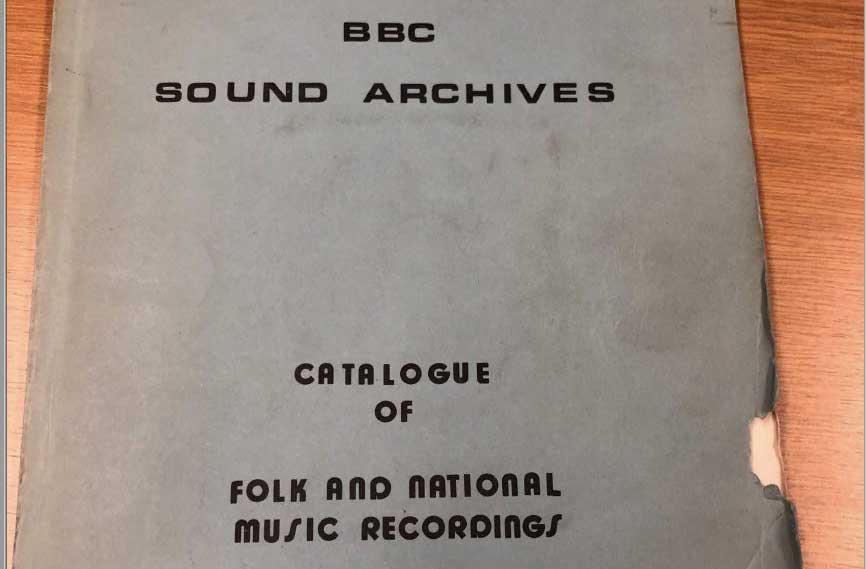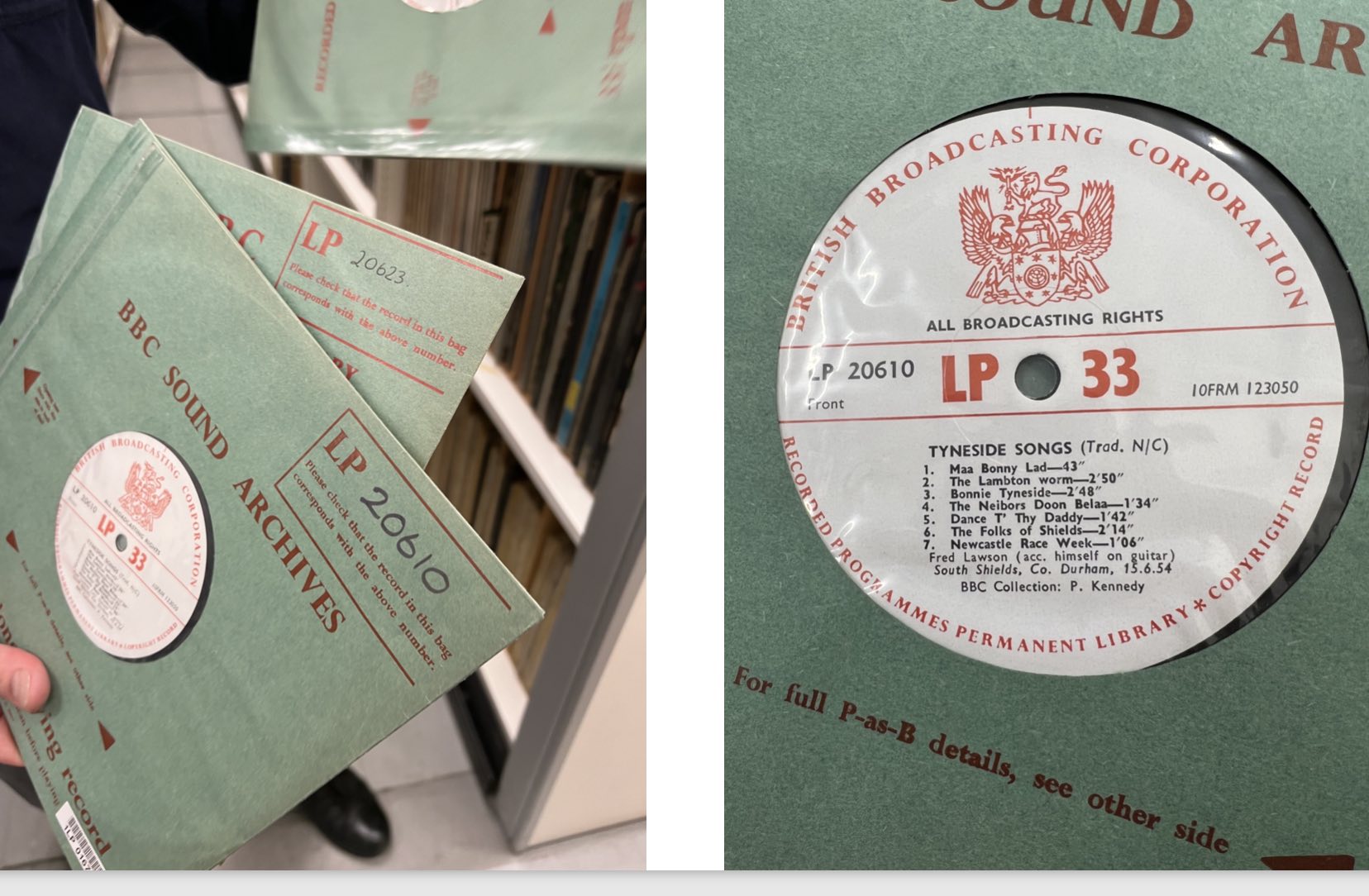BBC Field Recordings

In 1982, Madeau Stewart compiled a guide to the BBC Sound Archives - recordings of what she categorized as folk, national, ritual, religious and classical music from all countries, excluding Great Britain. As the Telegraph writes “she took on the task of augmenting the BBC’s early music and non-British folk and indigenous music archives."
After the war she got a job as a selector for the BBC's Sound Archives, which at that time consisted mainly of spoken material. Finding that there was a growing demand from programme-makers for appropriate theme and incidental music for period dramas and travel series, she took on the task of augmenting the BBC's early music and non-British folk and indigenous music archives, a job which involved travelling around the world to collect recordings from far-flung parts and gathering in material from itinerant contributors.
Tom Hatfield, one of these ‘itinerant contributors’ describes how Madeau allowed him " whilst a penniless student, to go round France recording hurdy-gurdies" and lent him from the BBC engineering department what was then cutting edge technology, a device that recorded sound on tape(!), which apparently worked off batteries and weighed half a ton."
He goes on to say what happened to some of these recordings. In this instance, he recounts how "Madeau’s skill and enthusiasm helped convert my hair-brained scheme into an eventual programme, which she produced, along with one I did ten years later on the music of the Tuaregs, which was broadcast at a particularly quiet time on the BBC Third Programme but nevertheless made quite a stir among connoisseurs of the genre. After she left, I made a fruitless proposal of a programme on pre-Columbian music to some suit who didn’t know the difference between a crumhorn and a Tibetan nose flute."
Madeau Stewart's introduction to the BBC Sound Archive compilation gives further indication to what the BBC Field recordings were for and how they were obtained:
CATALOGUE RAISONNÉ
A guide to the BBC Sound Archives recordings of folk, national, ritual, religious and classical music from all countries, excluding Great Britain. All the recordings are ABR ( All Broadcasting Rights) therefore no payment is required when they are used.)
A highly selective process has been exercised in creating this catalogue raisonné. Much of inferior musical or technical quality or of doubtful origin has been omitted. Poor or inadequate documentation has made it difficult to be sure that entries and descriptions are always accurate. Whilst the Catalogue was in preparation during 1979 /80 at least two countries achieved independence and changed their names - not always in time to correct the alphabetical list of entries; thus New Hebrides, now Vanuatu, retains its earlier name. The Catalogue includes material in the BBC Folk and National Music Recordings Volume 1, Foreign Countries, 1958.
It is important to remember that collectors (a list will be found under COLLECTORS) exercise selection when recording and that the BBC exercised further selection when purchasing for Sound Archives. Thus, recordings from a country or a region should not necessarily be taken as being typical of that place.
A special tribute should be paid to all collectors for their contribution to this collection and in particular to those who undertook hazardous journeys into remote regions to record and thereby preserve for parity music of incalculable value. Musicology or ethnomusicology has never had the international support that archaeology has enjoyed and most of the collectors hardly broke even let alone made a profit.
SUMMARY OF COLLECTION
The global turmoils of recent years which include industrialization and mechanisation, have destroyed both the need for and the belief in many musics. The Archive collection has, sadly, to be accepted as a record of the past, often a very deep past. As no plan was made and no discipline exercised as to who went where to record what, the collection as a whole is a random one and all the gaps show up clearly. In many cases these gaps can be filled by recordings held in the National Sound Archive, London.

The catalogue is categorized topically - either through the name of country with a summary of the material and list of subject entries, or through subject entries like "Panpipes" with the name of the ethnolinguistic group ( if known) - or otherwise the locality - followed by the name of country. The subject entries provide comparative tables. - thus under Panpipes, will be found all the countries where panpipes have been recorded.
An example is Madeau Stewart's entry for Burma:
Burma
From 1951 until 1961 all archives contained of Burmese music was a curiously horrific series of 78’s ( 16643–16650) in which a Burmese actor age 69 called U Po Sein, sang a number of undistinguished songs to the accompaniment ofThet sein at the pianoforte.
In 1961. Stewart Wavell of the BBC Burmese Service made a collecting trip to Burma. When I first heard the tapes, I felt very uneasy about the authenticity of the music and the proficiency of the instrumentalist in everything but the tribal music hearing collection after a gap of 20 years, my uneasiness is in no way dispelled. Much of the tribal music has a rather sinister character and can be monotonous. The classical music seems to express a tradition in decline. The following number of entries must no way be interpreted as an indication of the richness of the music, it is only an attempt to sort it all out in spite of feeble documentation into relevant categories.
Animals Ballads Bells Buddhist Curiosities Dances Drone
Drums general drums melodic Fireworks flute Funeral
Gongs Gong, Orchestras Harmony Horns
Instrumental groups Jaw’s Harp
Harp National anthems Oboe Panpipes
Pipes single Pipes double Political Processions
Royal music Similarities Snake charmers Street musicians Tunes
Violin Western influence Work Xylophone
For Cambodia:
A sad little Collection. One side of LP 23647 and one track on LP 31675. The former is from radio UNESCO and labels seem to provide all the documentation there is.
see also Buddhist
Drama, musical sung
Fiddle
Gong, Orchestra
Hindu
Lute

Under the Subject heading for Castanets:
Known to ancient Egypt and probably before that. the prototype is said to be the bi-valve shell, A dancers' instrument. Prevalent in Spain, where the tradition was to play them in pairs, the higher pitch being female, the lower, the male a distinction to be found in the pitches of drums in various countries.
Morocco: Qaraqeb (castanets) with drum 37944 Ft 3 *
Philippines: dance accompanied bamboo castanets. 30816 Ft 6
Spain: Asturias: Pandero que toco: The higher sounding female castanet can be heard entering before the lower pitched male
Ibiza: Three Christmas songs: Large castanets; rattling good towards end 18817
* Accessibility note: These numbers are the BBC Sound archive's catalogue numbers. In rare cases, these can be cross-referenced with the British Library's online catalogue and can then be requested to be digitized and listened to onsite at the British Library. ( This process can take up to four weeks).
If the BBC accession number is not found the number needs to be submitted to the British Library's Listening Service , where they then go to the basement, physically look for the disc, catalogue it and then digitize it for the reader. This entire process can take up to 2 months.
